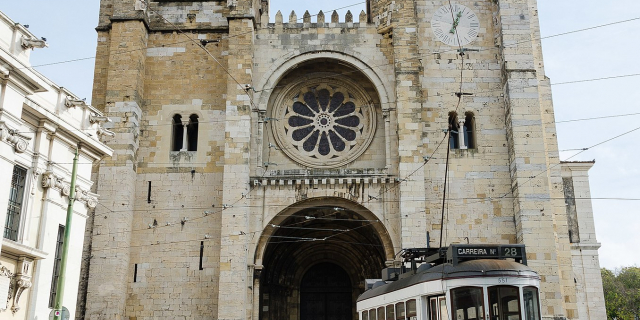Porto Covo is one of the two civil parishes in the municipality of Sines, located along the western Alentejo coast of Portugal, about 170 km (110 mi) south of Lisbon. The population in 2011 was 1,038, in an area of 50.72 km2. Known for its beaches and ties to the ocean, the name Porto Covo likely translates as port of the covos, the term covo referring to a fishing net, used for capturing lobsters and crabs.
 The island of Pessegueiro one of the first centres of activity in the region, leading back to the Carthaginian and Roman trade and commerce
The island of Pessegueiro one of the first centres of activity in the region, leading back to the Carthaginian and Roman trade and commerce The Forte da Ilha de Dentro along the beach of Pessegueiro
The Forte da Ilha de Dentro along the beach of PessegueiroThe earliest record of human settlement in the area of Porto Covo dates to the Carthaginian trading along the coast. By the time of the conquest of Hispania by Rome, the island of Pessegueiro hosted a small fish processing centre (from archaeological excavation of salt tanks linked to this industry).
The parish of Porto Covo, by the middle of the 18th century, was nothing more than a small coastal settlement around a beach and small cove.[1] Its small dimensions was reflected in the number of homes, which numbered only four by 1780. On the island of Pessegueiro, King Philip II of Spain hoped to found a maritime port to support his claim to the territory and defend against marauding pirates.[1] At that time an artificial rock barrier was constructed to connect the island of Pessegueiro to the coastline. Two forts were constructed on the island, supporting small garrisons to watch over the coast, but today in ruins.
Still in the 18th century, the community of Porto Covo began to become an anchorage for the small fishing boats and small businesses. Yet, even these activities were limited, due to the climatic and ocean conditions which limited the port's accessibility.[1] During these periods, it was difficult entering the cove and, in periods when storms came from the southwest, it was not safe attempting landfall on the island of Pessegueiro.[1]
The area began to occupy an important role after the capitalist Jacinto Fernandes Bandeira, a member of a merchant classes of the capital appeared around the late part of the 18th century.[1] Born on 28 April 1745, he came from a poor family in Viana do Castelo, working for family in the capital, succeeding and becoming wealthy under the government of the Marquess de Pombal: in 1768, at the age of 23, his was a member of the Inquisition; in 1774, he was made a knight in the Order of Christ; and in 1792, he was a secretary, deputy and, later, inspector in the Junta de Comérico (Commission for Commerce).[1] He began using the stylized Bandeira to his name, after being born along the Rua da Bandeira in Viana do Castelo.[1] With his career in ascendancy, Jacinto Fernandes began collecting aristocratic titles, such as the Loyal Knight of the Royal House (Fidalgo Cavaleiro da Casa Real), in 1794.[1] He obtained the right to use the name Senhor de Porto Covo after 13 June 1796, for "his activity to promote the establishment and settlement of Porto Covo, to benefit agriculture, fishing and promotion of the Corte, in addition to diverse commissions in which he held with satisfaction".[1] He realized his project to establish a permanent settlement in Porto Covo, by producing two plans (now archived in the Torre do Tombo National Archive.[1][2] Jacinto Fernandes became the alcalde of Vila Nova de Milfontes on 14 November 1802 and later the council to the Royal Finances. He was given the title of Baron of Porto Covo on 15 August 1805.[1]
While he lived Jacinto Fernandes Bandeira strove to grow the community, a fact that did not influence his successors, following his death on 30 May 1806.[1] A bachelor, he left his enormous fortune to his two nephews, children of his sister, Maria Josefa Cristina Bandeira.[1] It was the eldest nephew, Jacinto Fernandes da Costa Bandeira, that inherited the majority from his uncle, succeeding his uncle as the alcalde of Vila Nova de Milfontes, and second Baron of Porto Covo on 26 February 1822.[1] For his contribution to the Crown, he went as far as Minister for Finances and President of the Bank of Lisbon, eventually achieving the title of Viscount of Porto Covo da Bandeira on 15 September 1843. By this time, Porto Covo had little more than 20 residences: little more than the original nucleus left behind on the death of the first Baron.[1] Porto Covo never really achieved an important place along the Alentejo coast. The area on which it was located remained unsettled; the area between Sines and the River Mira were likely destinations for fishermen and traders then the village. Fishing tended to remain archaic and never really commercialized by its population.[1]
Demographically, by 1940, Porto Covo had little more than 55 residences, comprising 246 inhabitants.[1] After 1980 the numbers had grown significantly: 194 residences, comprising 539 inhabitants.[1] Its growth was, in some part, achieved through the development of the Sines Industrial Complex and container port.[1]
Porto Covo became a civil parish on 31 December 1984, that included the island of Pessegueiro.[1]
































Add new comment